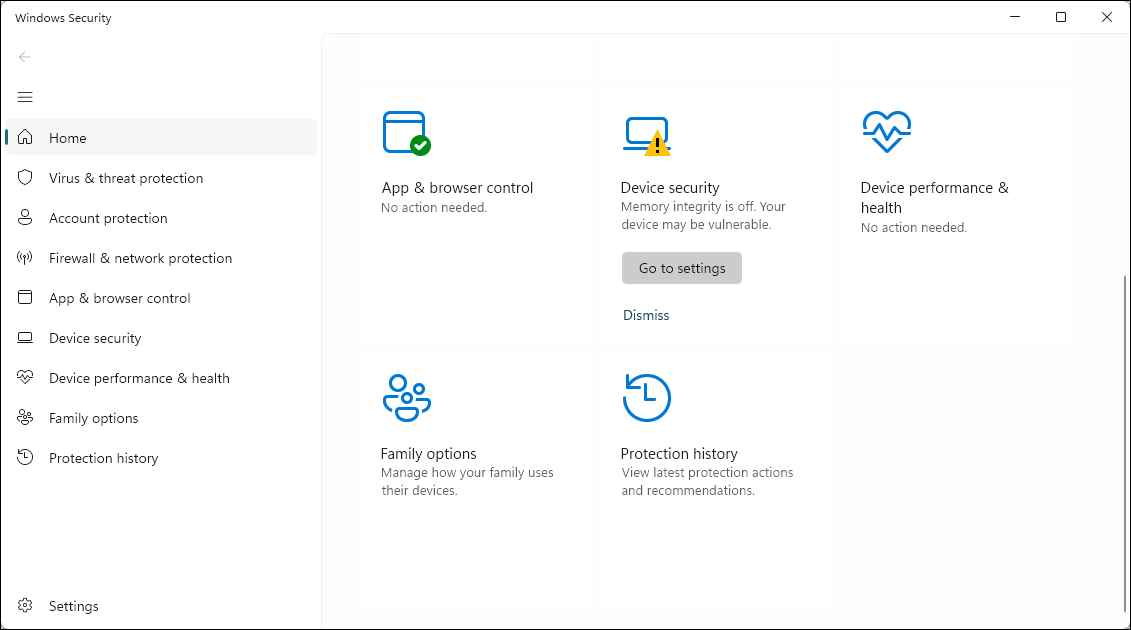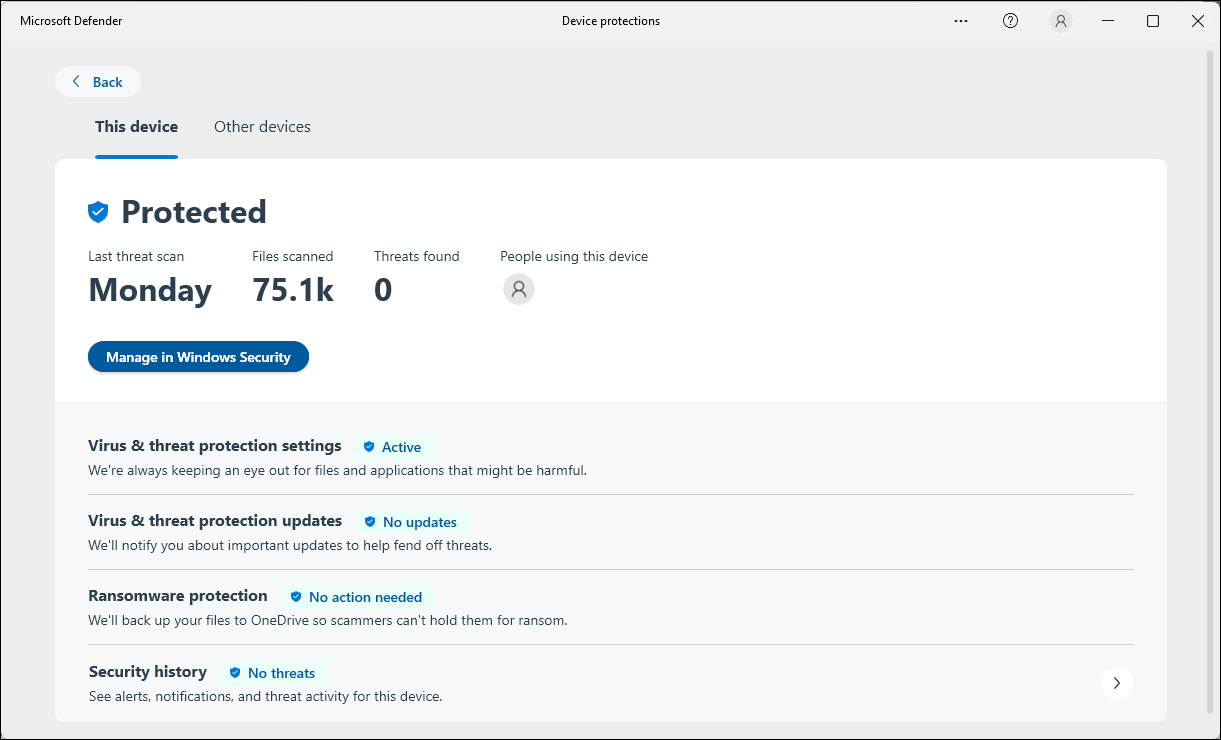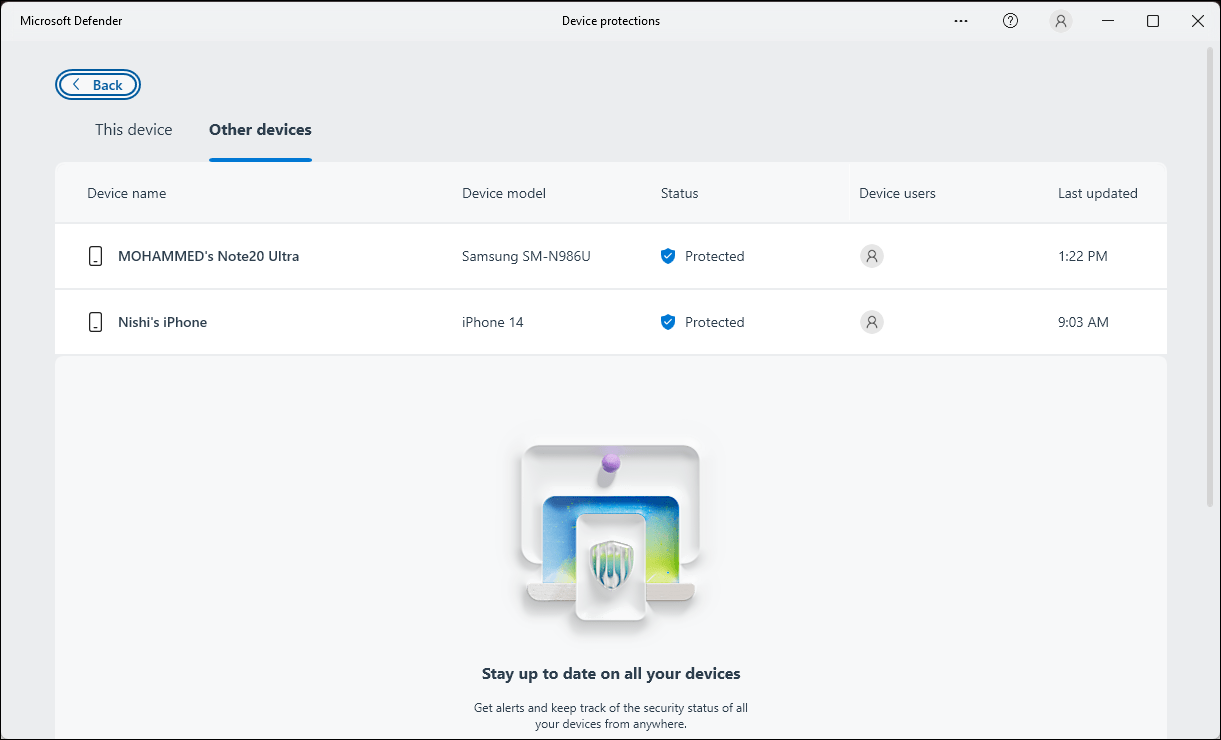Did You Know There Are Two Different Microsoft Defender Apps?
Your Windows computer comes with Windows Security, a built-in but barebone security solution. You can get more premium features by installing Microsoft Defender, a standalone security app for Windows, Mac, iPhone, and Android devices. If that sounds confusing, blame Microsoft's atrocious naming game. But these two are separate security solutions and offer different, albeit complementing features. Let’s explore the differences between them.
What is Windows Security?

Formerly known as Windows Defender (which would have made the nomenclature even more confusing), Windows Security is a built-in antivirus and firewall solution within the Windows operating system. It offers essential protection against offline and online threats, including manual scans and threat management capabilities.
If you have a Windows computer, chances are you’ve used it before, and it is probably the only antivirus your computer will ever need. Here's what you get with Windows Security:
- Virus & threat protection: Windows Security uses the Microsoft Defender Antivirus engine at the core of its security solution to provide real-time protection against malware. You can perform a quick, custom, or offline scan, adjust ransomware settings, manage controlled folder access, and create exclusion lists.
- Account Protection: Secure your Microsoft account settings, including login, account recovery, and password options.
- Firewall & network protection: Customize your firewall settings on different networks and configure inbound and outbound traffic rules.
- App & browser control: You can control how Windows screens your apps for malware and customize SmartScreen settings to filter websites and downloads.
- Device Security: Allows you to access advanced security to monitor your system for core isolation, secure boot, and hardware security options.
- Device performance and health: This shows a quick overview of your device’s health, including battery life, storage capacity, and potential issues with apps and software.
- Family options: Manage parental control to set screen time habits, track your child’s digital activity, and filter accessible content on the PC.
What’s Microsoft Defender?
While it may sound similar, Microsoft Defender is a standalone security app for Windows, Android, iOS, and macOS. Microsoft clarifies that it’s not an antivirus replacement on Windows and iOS devices but offers malware protection on Android.

Microsoft Defender is part of the Microsoft 365 suite, so you don’t need to pay extra to install the app. If you are a subscriber, the app is likely already installed on your device. If not, you can install it from the Microsoft Store or your device’s respective app store.
Put simply, Microsoft Defender acts like an add-on that works alongside Windows Security or any third-party antivirus software installed on your computer or smartphone. However, it offers some of its own unique security features:
- Identity theft monitoring: Track 60 different types of personal data and get alerts when there’s a data breach or suspicious activity on your credit report.
- Identify theft insurance (US only): It provides up to USD 1 million in coverage for restoration costs and support in case of data breach or identity theft.
- Threat and suspicious activity alerts: Monitor and receive security alerts for up to five devices linked to your Microsoft account through a centralized dashboard.
- Device Protection: On Android, Microsoft Defender can scan for malicious apps, run a malware scan, check the blocked apps list, and block unsafe websites. However, iOS devices are limited to jailbreak detection and web protection only.
- Privacy protection: Browse privately by hiding your IP address through encryption with the included VPN service, which offers up to 50GB of data usage per month.
Windows Security vs Microsoft Defender: Which is Better?
Despite their confusing names, Windows Security and Microsoft Defender are not competing but complementary services. Windows Security is built into your Windows operating system for basic protection and runs locally on your computer. Microsoft Defender is an additional security layer that works with your existing antivirus solution. On a Windows computer, it acts like a security dashboard for Windows Security or your third-party antivirus.
So, even if you have Microsoft Defender on your computer or smartphone, it’s important not to turn off your built-in or third-party protection, as it’s not meant to replace it.

What sets Microsoft Defender apart is its centralized dashboard. Compared to third-party rivals, it works quietly in the background with minimal effect on system performance and no intrusive prompts. It allows you to view and manage security risks across all your devices from one place. It also includes additional features to protect your online presence across various devices, regardless of whether you use Windows or not.
Here's a quick comparison between Windows Security and Microsoft Defender:
Feature
Windows Security
Microsoft Defender
Centralized Dashboard
No
Yes
Antivirus/Anti-Malware
Yes
Yes
Firewall
Yes
No
Device Security
Yes
Yes
App & Browser Control
Yes
Yes
Family Options
Yes
Yes
Identify Theft
No
Yes
Cross-Device
No
Yes (Windows, Mac, Android, iOS)
Parental Controls
Yes
Yes
VPN
No
Yes (up to 50GB)
Password Manager
No
No
Subscription
Free
Microsoft 365 Personal/Family
Microsoft Defender Caveats…
Microsoft Defender is a nifty add-on for Microsoft 365 subscribers, but there are some caveats. Microsoft Defender’s premium features are largely restricted to the US. For instance, at the time of writing, the VPN service is limited to Android and iOS devices in the US, Canada, Germany, and the UK. Moreover, you can’t manually select a geo-location and are capped at 50GB of data per month.
Identity theft monitoring and identity theft insurance are also exclusively available to US users. And while you benefit from antivirus protection and malicious app scanning on Android, iOS users only have access to web protection and jailbreak detection.
So, even if you are a Microsoft 365 subscriber, the availability of features can vary depending on the device/platform and region. You won't miss out on anything if you are in the US, though.
Should You Use Microsoft Defender?
Microsoft Defender for Individuals is a premium service bundled with your Microsoft 365 subscription. In the absence of a dedicated antivirus solution, depending on your region, you can use Microsoft Defender to make up for the security features missing in Windows Security, like identity theft management, VPN, and centralized management of multiple devices. When combined, Microsoft’s security offering should keep you safe both offline and online.
However, if you are not a Microsoft 365 subscriber and want premium security features, a dedicated third-party antivirus tool can offer more features with fewer restrictions.
-
 Full Guide - Black Ops 6 Stuck on Loading Screen on PCDo you encounter issues with the loading screen during the Early Access Beta of Call of Duty Black Ops 6? What can you do to fix this annoying error? ...Software tutorial Published on 2024-11-02
Full Guide - Black Ops 6 Stuck on Loading Screen on PCDo you encounter issues with the loading screen during the Early Access Beta of Call of Duty Black Ops 6? What can you do to fix this annoying error? ...Software tutorial Published on 2024-11-02 -
 Stardock DesktopGPT Is an AI Power Users\' Copilot Replacement"With DesktopGPT, Stardock is bringing the power of AI to desktop with unique features that makes it easy to jump in-and-out of interacting...Software tutorial Published on 2024-11-02
Stardock DesktopGPT Is an AI Power Users\' Copilot Replacement"With DesktopGPT, Stardock is bringing the power of AI to desktop with unique features that makes it easy to jump in-and-out of interacting...Software tutorial Published on 2024-11-02 -
 2 Options to Prevent Users from Changing Desktop Wallpaper in Windows 10After you set a desktop wallpaper for your computer, you might not want others to change it. Now in this post, we will show you how to prevent users f...Software tutorial Published on 2024-11-02
2 Options to Prevent Users from Changing Desktop Wallpaper in Windows 10After you set a desktop wallpaper for your computer, you might not want others to change it. Now in this post, we will show you how to prevent users f...Software tutorial Published on 2024-11-02 -
 Top 10 Fixes for HDMI Port Not Working on MacFollowing a short absence, the HDMI port returned in the latest MacBook Pro line up. Mac Mini and Mac Ultra also have HDMI ports to connect a monitor ...Software tutorial Published on 2024-11-02
Top 10 Fixes for HDMI Port Not Working on MacFollowing a short absence, the HDMI port returned in the latest MacBook Pro line up. Mac Mini and Mac Ultra also have HDMI ports to connect a monitor ...Software tutorial Published on 2024-11-02 -
 Guide on KB5044285 Download & KB5044285 Fails to InstallWhat can you do if the latest Windows 11 update KB5044285 fails to install? If you are not sure how to fix it, read this post on MiniTool Software to ...Software tutorial Published on 2024-11-02
Guide on KB5044285 Download & KB5044285 Fails to InstallWhat can you do if the latest Windows 11 update KB5044285 fails to install? If you are not sure how to fix it, read this post on MiniTool Software to ...Software tutorial Published on 2024-11-02 -
 How to Resize or Reduce Photo Size on iPhone and iPadQuick LinksHow to Resize a Photo Using Shortcuts How to Resize a Photo Using a Third-Party App The editor in the Photos app is quite feature-r...Software tutorial Published on 2024-11-02
How to Resize or Reduce Photo Size on iPhone and iPadQuick LinksHow to Resize a Photo Using Shortcuts How to Resize a Photo Using a Third-Party App The editor in the Photos app is quite feature-r...Software tutorial Published on 2024-11-02 -
 How to Fix No Text Message Alerts or Sounds on iPhone: 15+ SolutionsIf text messages are not showing up on your iPhone, your device isn't displaying notifications for an incoming SMS or iMessage, or your locked iP...Software tutorial Published on 2024-11-02
How to Fix No Text Message Alerts or Sounds on iPhone: 15+ SolutionsIf text messages are not showing up on your iPhone, your device isn't displaying notifications for an incoming SMS or iMessage, or your locked iP...Software tutorial Published on 2024-11-02 -
 How to Enable PIN Requirements and Create a Complexity PINWindows Hello in Windows 10 enables users to sign in to their device using a PIN (Personal Identification Number). You can use this PIN to sign in to ...Software tutorial Published on 2024-11-02
How to Enable PIN Requirements and Create a Complexity PINWindows Hello in Windows 10 enables users to sign in to their device using a PIN (Personal Identification Number). You can use this PIN to sign in to ...Software tutorial Published on 2024-11-02 -
 How to Bypass Google FRP on Android for FreeWhat Is Google Factory Reset Protection or FRP Google introduced a new security mechanism in its Android operating systems starting from Android 5.1. ...Software tutorial Published on 2024-11-02
How to Bypass Google FRP on Android for FreeWhat Is Google Factory Reset Protection or FRP Google introduced a new security mechanism in its Android operating systems starting from Android 5.1. ...Software tutorial Published on 2024-11-02 -
 Microsoft Should Focus on Making Windows 11 Better, Not Just More FunWith new Copilot features being released in quick succession, it's clear what Microsoft is prioritizing with Windows 11 and beyond. Apart from th...Software tutorial Published on 2024-11-02
Microsoft Should Focus on Making Windows 11 Better, Not Just More FunWith new Copilot features being released in quick succession, it's clear what Microsoft is prioritizing with Windows 11 and beyond. Apart from th...Software tutorial Published on 2024-11-02 -
 Satisfactory Crashing on PC: Fix with Four Feasible SolutionsRecently, several Satisfactory players reported that they are unable to access the game as Satisfactory crashing on PC constantly. Is there any soluti...Software tutorial Published on 2024-11-02
Satisfactory Crashing on PC: Fix with Four Feasible SolutionsRecently, several Satisfactory players reported that they are unable to access the game as Satisfactory crashing on PC constantly. Is there any soluti...Software tutorial Published on 2024-11-02 -
 Cannot Access NAS With SMB in Windows 11 24H2: Why & FixesRecently some users reported that they cannot access NAS with SMB in Windows 11 24H2. What are the reasons behind this situation? What should you do i...Software tutorial Published on 2024-11-02
Cannot Access NAS With SMB in Windows 11 24H2: Why & FixesRecently some users reported that they cannot access NAS with SMB in Windows 11 24H2. What are the reasons behind this situation? What should you do i...Software tutorial Published on 2024-11-02 -
 Apple Journal vs. Day One: Which Journaling App Is BetterApple introduced a new Journal app with an iOS 17 update on iPhone. As the name suggests, it helps you capture and write about important moments of yo...Software tutorial Published on 2024-11-02
Apple Journal vs. Day One: Which Journaling App Is BetterApple introduced a new Journal app with an iOS 17 update on iPhone. As the name suggests, it helps you capture and write about important moments of yo...Software tutorial Published on 2024-11-02 -
 Some iPhone Alarms Are Broken, But a Fix is ComingNo one likes missing their alarm, especially when it's the clock's fault. If you have an iPhone and you've missed some alarms over the pa...Software tutorial Published on 2024-11-02
Some iPhone Alarms Are Broken, But a Fix is ComingNo one likes missing their alarm, especially when it's the clock's fault. If you have an iPhone and you've missed some alarms over the pa...Software tutorial Published on 2024-11-02 -
 Windows 11 Shows Start Menu Ads Now: Here’s How to Turn Them OffWindows 11 has started displaying ads in the Start menu. While we don't really like to put companies on blast, nobody wants this, and it's a ...Software tutorial Published on 2024-11-02
Windows 11 Shows Start Menu Ads Now: Here’s How to Turn Them OffWindows 11 has started displaying ads in the Start menu. While we don't really like to put companies on blast, nobody wants this, and it's a ...Software tutorial Published on 2024-11-02
Study Chinese
- 1 How do you say "walk" in Chinese? 走路 Chinese pronunciation, 走路 Chinese learning
- 2 How do you say "take a plane" in Chinese? 坐飞机 Chinese pronunciation, 坐飞机 Chinese learning
- 3 How do you say "take a train" in Chinese? 坐火车 Chinese pronunciation, 坐火车 Chinese learning
- 4 How do you say "take a bus" in Chinese? 坐车 Chinese pronunciation, 坐车 Chinese learning
- 5 How to say drive in Chinese? 开车 Chinese pronunciation, 开车 Chinese learning
- 6 How do you say swimming in Chinese? 游泳 Chinese pronunciation, 游泳 Chinese learning
- 7 How do you say ride a bicycle in Chinese? 骑自行车 Chinese pronunciation, 骑自行车 Chinese learning
- 8 How do you say hello in Chinese? 你好Chinese pronunciation, 你好Chinese learning
- 9 How do you say thank you in Chinese? 谢谢Chinese pronunciation, 谢谢Chinese learning
- 10 How to say goodbye in Chinese? 再见Chinese pronunciation, 再见Chinese learning

























